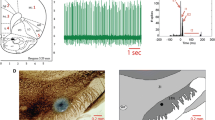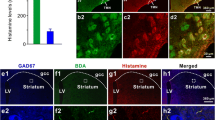Summary
We have investigated the influence of D1 and D2 dopamine receptor active drugs on dopamine (DA) release in substantia nigra (SN), striatum and limbic forebrain in intact and in hemisected rats in vivo. DA release was indirectly assessed as 3-methoxytyramine (3-MT) accumulation following monoamine oxidase inhibition by pargyline. Hemisection per se had no effect on the 3-MT accumulation in the SN. Neither, had SCH 23390, SK & F28393, or cisflupentixol any effect in the SN in intact animals or in the lesioned side in hemisected animals. SCH 23390 slightly increased the 3-MT accumulation both in the striatum and limbic forebrain, indicating a stimulatory action on DA release, but SK & F38393 had no effect in these brain regions. A difference between the striatum and the limbic forebrain was that the effects of SCH 23390, and cis-FPX were almost abolished following hemisection in the limbic fore-brain, but only partially reduced in the striatum. In summary, our data give further support for the concept that neither D 1 nor D 2 dopamine receptors have any pronounced influence on the DA release in the SN. The data also indicate operational differences in the feedback regulation of limbic versus striatal dopaminergic transmission.
Similar content being viewed by others
References
Andén N-E (1977) Shortlasting increase in the synthesis and utilization of noradrenaline due to axotomy-induced irritation. Acta Physiol Scand 100: 51–55
Andén N-E (1980) Regulation of monoamine synthesis and utilization by receptors. In: Szekeres L (ed) Handbook of experimental pharmacology, vol 27. Springer, Berlin Heidelberg New York, pp 429–462
Andén N-E, Golembiowska-Nikitin K, Thronström U (1982) Selective stimulation of DA and noradrenaline autoreceptors by B-HT 920 and B-HT 933, respectively. Naunyn-Schmiedebergs Arch Pharmacol 321: 100–104
Anton AH, Sayre DF (1962) A study of the factors affecting the aluminum oxidetrihy-droxyindole procedure for the analysis of catecholamines. J Pharmacol Exp Ther 138: 360–375
Arnt J, Hyttel J (1985) Different involvement of dopamine D-1 and D-2 receptors in the circling behaviour induced by apomorphine, SK & F38393, pergolide and LY 171555 in 6-hydroxydopamine-lesioned rats. Psychopharmacology 85: 346–352
Bannon MJ, Reinhard JF, Bunnex EB, Roth RH (1982) Unique response to antipsychotic drugs due to absence of terminal autoreceptors in mesocortical DA neurones. Nature 296: 444–446
Bischoff S, Heinrich M, Sonntag JM, Krauss J (1986) The D-1 dopamine receptor antagonist SCH 23390 also interacts potently with brain serotonin (5-HT2) receptors. Eur J Pharmacol 129: 367–370
Bouthenet M-L, Martres M-P, Sales N, Schwartz J-C (1987) A detailed mapping of dopamine D-2 receptors in rat central nervous system by autoradiography with [125I]iodosulpiride. Neuroscience 20: 117–155
Brown EE, Damsma G, Cumming P, Fibiger HC (1991) Interstitial 3-methoxytyramine reflects striatal dopamine release: an in vivo microdialysis study. J Neurochem 57: 701–707
Carlson JH, Bergstrom DA, Walters JR (1986) Neurophysiological evidence that D-1 dopamine receptors blockade attenuates postsynaptic but not autoreceptor-mediated effects of dopamine agonists. Eur J Pharmacol 23: 237–251
Carlsson A, Lindqvist M (1973) Effect of ethanol on the hydroxylation of tyrosine and tryptophan in rat brain in vivo. J Pharm Pharmacol 25: 437–440
Chéramy A, Barbeito L, Godeheu G, Desce JM, Pittaluga A, Galli T, Artaud F, Glowinski J (1990) Respective contributions of neuronal activity and presynaptic mechanisms in the control of the in vivo release of dopamine. J Neural Transm 29: 183–193
Cross AJ, Mashal RD, Johnson JA, Owen F (1983) Preferential inhibition of ligand binding to calf striatal dopamine D 1 receptors by SCH 23390. Neuropharmacology 22: 1327–1329
Cuello AC, Iversen LL (1978) Interaction of dopamine with other neurotransmitters in the rat substantia nigra: a possible functional role of dendritic dopamine. In: Garattini S, Pujol JF, Samanin R (eds) Interactions between putative neurotransmitters in the brain. Raven Press, New York, pp 127–149
Di Chiara G, Imperato A (1985) Rapid tolerance to neuroleptic-induced stimulation of dopamine release in freely moving rats. J Pharmacol Exp Ther 235: 487–494
Felice LJ, Felice JD, Kissinger PT (1978) Determination of catechol-amines in rat brain parts by reverse-phase ion-pair liquid chromatography. J Neurochem 31: 1461–1465
Filloux FM, Wamsley JK, Dawson TM (1987) Presynaptic and postsynaptic D 1 dopamine receptors in the nigrostriatal system of the rat brain: a quantitative autoradiographic study using the selective D 1 antagnoist [3H]SCH 23390. Brain Res 408: 205–209
Gale K, Guidotti A, Costa E (1977) Dopamine sensitive adenylate cyclase: location in substantia nigra. Science 195: 503–505
Hassler R, Back IJ (1969) Unbalanced rations of striatal dopamine and serotonin after experimental interruption of strionigral connections in rat. In: Gillingham FJ, Donaldson IML (eds) Third symposium on Parkinson's disease. Livingstone, Edinburgh London, pp 29–37
Hjorth S, Carlsson A (1988) In vivo receptor binding, neurochemical and functional studies with the dopamine D-1 receptor antagonist SCH 23390. J Neural Transm 72: 83–97
Imperato A, Mulas A, Di Chiara G (1987) The D-1 antagonist SCH 23390 stimulates while the D-1 agonist SK & F 38393 fails to affect dopamine release in the dorsal caudate of freely moving rats. Eur J Pharmacol 142: 177–181
Jaskiw GE, Weinberger DR, Crawley JN (1991) Microinjection of apomorphine into the prefrontal cortex of the rat reduces dopamine metabolite concentrations in microdialysate from the caudate nucleus. Biol Psychiatry 29: 703–706
Kehr W (1976) 3-Methoxytyramine as an indicator of impulse-induced dopamine release in rat brain in vivo. Naunyn-Schmiedebergs Arch Pharmacol 293: 209–215
Kelland MD, Freeman AS, Chiodo LA (1988) SKF 38392 alters the rate dependent D 2-mediated inhibition of nigrostriatal but not mesoaccumbens dopamine neurons. Synapse 2: 416–423
Leviel V, Kerny C, Barberis C, Guibert B, Daudet F (1984) Blockade by frontocortical lesion of reciprocal regulation between the two nigrostriatal dopaminergic pathways. Neuroscience 13: 53–59
Magnusson O, Nilsson LB, Westerlund D (1980) Simultaneous determination of dopamine, DOPAC and homovanillic acid. Direct injection of supernatants from brain tissue homogenates in a liquid chromotography-electrochemical detection system. J Chromatogr 221: 237–247
Mailman RB, Schultz DW, Lewis MH, Staples L, Rollema H, Dehaven DL (1984) SCH 23390: a selective dopamine antagonist with potent D 2 behavioral actions. Eur J Pharmacol 101: 159–160
Markwell MAK, Haas SM, Bieber LL, Tolbert NE (1978) A modification of the Lowry procedure to simplify protein determination in membrane and lipoprotein samples. Anal Biochem 87: 206–210
Morelli M, Carboni E, Devoto S, Di Chiara G (1987) 6-Hydroxydopamine lesions reduce specific [3H]sulpiride binding in the rat substantia nigra: direct evidence for the existence of nigral D-2 autoreceptors. Eur J Pharmacol 140: 99–104
Nieoullon A, Chéramy A, Glowinski J (1977) Release of dopamine in vivo from cat substantia nigra. Nature 266: 375–377
Nissbrandt H, Sundström E, Johnsson G, Hjorth S, Carlsson A (1989) Synthesis and release of dopamine in rat brain: comparison between substantia nigra pars compacta, pars reticulata and striatum. J Neurochem 52: 1170–1182
Onali P, Mereu G, Olianas MC, Bunse B, Rossetti Z, Gessa GL (1985) SCH 23390, a selective D 1 dopamine receptor blocker, enhances the firing rate of nigral dopaminergic neurons but fails to activate striatal tyrosine hydroxylase. Brain Res 340: 1–7
Phillipson OT, Emson PC, Horn AS, Jessel T (1977) Evidence concerning the anatomical location of the dopamine stimulated adenylate cyclase in the substantia nigra. Brain Res 136: 45–58
Plantjé JF, Daus FJ, Hansen HA, Stoof JC (1984) SCH 23390 blocks D-1 and D-2 dopamine receptors in rat neostriatum in vitro. Naunyn-Schmiedebergs Arch Pharmacol 327: 180–182
Porceddu ML, Giorgi O, De Montis G, Mele S, Cocco L, Ongini E, Biggio G (1987) 6-Hydroxydopamine-induced degeneration of nigral dopamine neurons: differential effect on nigral and striatal D-1 dopamine receptors. Life Sci 41: 697–706
Robertson GS, Damsma G, Fibiger HC (1991) Characterization of dopamine release in the substantia nigra by in vivo microdialysis in freely moving rats. J Neurosci 11: 2209–2216
Romo R, Chéramy A, Godeheu G, Glowinski J (1984) Direct commissural pathways are involved in the enhanced releas of dopamine induced in the contralateral caudate nucleus and substantia nigra by unilateral application of GABA in the cat thalamic motor nuclei. Brain Res 308: 43–52
Saller CF, Salama AI (1986) 3-Methoxytyramine accumulation: effects of typical neuro-leptics and various atypical compounds. Naunyn-Schmiedebergs Arch Pharmacol 334: 125–132
Santiago W, Westerink BHC (1991) Characterization and pharmacological responsiveness of dopamine release recorded by microdialysis in the substantia nigra of conscious rats. J Neurochem 57: 738–747
Savasta M, Dubois A, Benavides J, Scatton B (1986) Different neuronal location of [3H]SCH 23390 binding sites in pars reticulata and pars compacta of the substantia nigra in the rat. Neurosci Lett 72: 265–271
Starr MS (1987) Opposing roles of dopamine D1 and D2 receptors in nigra γ-[3 H]aminobutyric acid release? J Neurochem 49: 1042–1049
Svensson K, Hjorth S, Clark D, Carlsson A, Wikström A, Andersson B, Sanchez D, Johansson AM, Arvidsson L-E, Hacksell U, Nilsson JLG (1986) (+)-UH 232 and (+)-UH 242: novel stereoselective dopamine receptor antagonists with preferential action on autoreceptors. J Neural Transm 65: 1–27
Westerink BHC (1979) Effects of drugs on the formation of 3-methoxy-tyramine, a dopamine metabolite, in the substantia nigra, striatum, nucleus accumbens and tuberculum olfactorium of the rat. J Pharm Pharmacol 31: 94–99
Wood PL, Altar CA (1988) Dopamine release in vivo from nigrostriatal, mesolimbic, and mesocortical neurons: utility of 3-methoxytyramine measurements. Pharmacol Rev 40: 163–187
Zetterström T, Ungerstedt U (1984) Effects of apomorphine on the in vivo release of dopamine and its metabolites, studied by brain dialysis. Eur J Pharmacol 97: 29–34
Author information
Authors and Affiliations
Rights and permissions
About this article
Cite this article
Nissbrandt, H., Hjorth, S. Dopaminergic neurotransmission in somatodendritic and terminal areas of the rat brain: susceptibility to modulation by D 1 and D2 receptors and to axotomy. J. Neural Transmission 90, 13–26 (1992). https://doi.org/10.1007/BF01250514
Received:
Accepted:
Issue Date:
DOI: https://doi.org/10.1007/BF01250514




